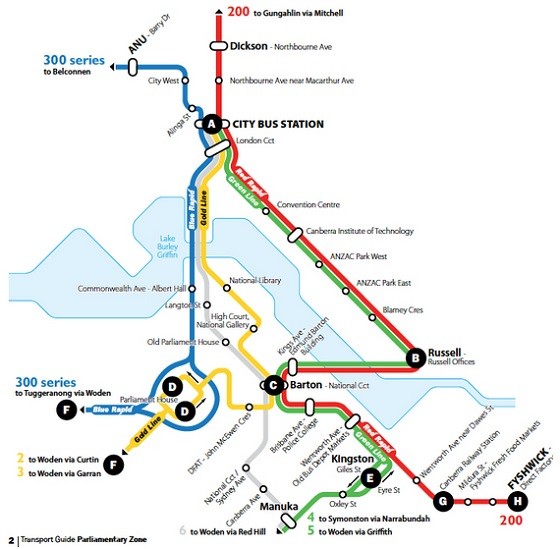
Art critic Robert Nelson says Canberra is an example of how planning, on the rare occasions when it’s done thoroughly, mostly results in something we scorn. He says Canberra is:
a place with no sense of community, with an automotive footprint and hardly any people. Though its architect, Walter Burley Griffin, is still respected, Canberra has no urbanistic qualities: it’s an antisocial city in denial of people with feet.
This is only a brief aside by Associate Professor Nelson (whose main purpose is an apologia for development), but it’s a persistent stereotype of Canberra (1). It’s reminiscent of the harsh criticisms made by former political speech writer Martin McKenzie Murray earlier this year in the Sydney Morning Herald.
But is Canberra really that awful? Or is it yet another case of typecasting that endures because observers don’t update their views? It’s worth looking again at some of the points I discussed once before in What’s good about Canberra?
Contrary to Professor Nelson’s charge that it is “a place with no sense of community”, Canberra outstrips other Australian cities in social capital (e.g. see Why does Canberra have more social capital?)
According to Dr Andrew Leigh, author of Disconnected, Canberrans are more likely to give time and money, engage in the political process, and participate in local sports than residents of Australia’s other major cities (2).
On virtually every social capital measure, the ACT is at or near the top relative to other states. It has the highest share of charitable donors and the highest volunteering rate. In a given year, 85 percent of Canberrans give money to other causes, compared with 73 percent of those in NSW. When it comes to giving time, 38 percent of Canberrans volunteer in a given year, compared with 33 percent of Victorians.
Dr Leigh says Canberra’s lead holds even after allowing for differences between jurisdictions in factors like income and education.
He says it’s primarily due to short commutes and a conducive physical environment – all those parks, cycleways and neighbourhood shopping centres. I think Canberra’s small population size and high level of car use are another part of the explanation.
Notwithstanding the “automotive footprint” that Professor Nelson refers to, Canberra is also Australia’s cycling capital.
The National Cycling Participation Survey for 2013 published this month shows that 24.5% of ACT residents polled say they cycled in the last week. This is much higher than the Australian average of 16.6% and higher than any other state or territory.
The bicycle has by far the highest mode share for the journey to work in Canberra of the major capital cities too. It was 2.7% in 2011 compared to 1.5% in Melbourne (0.9% in Sydney). This is not a new phenomenon either – Canberra has been well clear of the pack since 1991.
Canberra has two of the entrants – Canberra City and Braddon – on Urbis’s list of the ‘21 Hippest Suburbs in Australia‘. That’s the same number as Brisbane and Perth each have. These two suburbs have the highest proportions of tertiary educated and singles of any of the “hippest” suburbs in Australia, suggesting they’re highly unlikely to be dull places to live.
Moreover, they’re in the top decile for population density in this group. Doubters who think Canberra is all quarter acre blocks should take a tour of Canberra City and adjacent Braddon via Google Maps. Canberra City is rated as a “Walker’s Paradise” by Walkscore.
Canberra also does better on a number of other measures than popular perceptions of outsiders suggest.
Its metropolitan population density is lower than other mainland Australian capitals but the difference is small. Its population-weighted density is 20.8 persons/Ha, not that much less than Adelaide’s 22.3 and Perth’s 22.7. Canberra certainly isn’t Melbourne (33.1) or Sydney (52.1), but it’s not Atlanta either.
And although most of Canberra’s suburbs are low density, transit consultant Jarrett Walker points out that, unlike US cities, 1970s cul-de-sac suburbs such as Florey nevertheless provided links for pedestrians and cyclists.
Public transport’s mode share for commuting is relatively low at around 5% of all motorised passenger kms, but again the differences relative to other cities aren’t great. In Adelaide it’s around 6% and in Perth 7%.
Given its small population size (367,000), that’s a respectable performance in the context of Australia’s high level of car-orientation (Adelaide’s population is 1.3 million and Perth’s is 1.9 million).
As the exhibit shows, Canberra now has a downtown frequent transit service that should be the envy of many larger cities. The Blue Line provides 5-8 minute frequencies and the Green Line 15 minute frequencies. The Green and Gold Lines provide 20 minute frequencies (same as my local rail line).
And to top it all off, Canberra ranked close behind Sydney and Melbourne and higher than Adelaide and Brisbane (and New York!) in the 2010 Mercer quality of living survey (which urbanist Jeff Speck calls “the gold standard”).
Many of those who’re among the 5-10% of capital city populations who live in the inner city (i.e. within 5km of the CBD) might not like the suburban character of Canberra, but of course it’s much younger than the major Australian cities; it’s only 100 years old and most development happened from the 1950s.
It’s therefore no surprise its physical form was largely shaped by the imperatives of car-based travel (3). However I reckon it’s time those who write about cities updated their views on the nation’s capital – a city’s character and function are shaped by much more than density.
From today’s Crikey mail:
* So who’s right — Robert Nelson or Alan Davies? We invite you to write for Crikey on whether Canberra is a hellhole or a great place to live. Send in your entry by 10am Wednesday October 23 and we’ll bring you the best later in the week. Maximum 150 words, and please include your name or a moniker. The most convincing entry wins a Crikey book or DVD. Entries to boss@crikey.com.au.
Read the winners of the Crikey comp here… Canberra: dream city or nightmare?
Update: And same-sex marriage is legal in the ACT.
Update 2: Treasury exiled to real world.
___________________________________________
- I’ve no idea what Professor Nelson means when he disses Canberra for having “hardly any people”. How can that be regarded as a failing?
- Dr Leigh is a former Professor of Economics at ANU and is now the Federal Member for the seat of Fraser in the ACT.
- Commenter Iain L noted in relation to an earlier article that “The Griffin’s winning entry for Canberra envisaged a fundamentally different city to what has been created today on the Molonglo. The original bid drawings depict a dense city of terraced housing, connected by a rapid transit system of trams running along the wide median strips. It seems almost only the street layout is what remains of the Griffin’s original concepts. Inner suburbs of Reid and Campbell appear almost Parisian.”








Crikey is committed to hosting lively discussions. Help us keep the conversation useful, interesting and welcoming. We aim to publish comments quickly in the interest of promoting robust conversation, but we’re a small team and we deploy filters to protect against legal risk. Occasionally your comment may be held up while we review, but we’re working as fast as we can to keep the conversation rolling.
The Crikey comment section is members-only content. Please subscribe to leave a comment.
The Crikey comment section is members-only content. Please login to leave a comment.